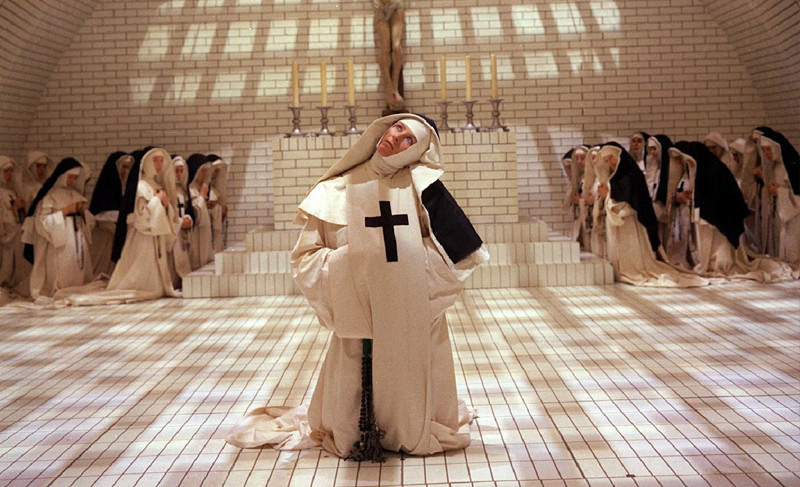
There are numerous examples of popular movies that feature a nun as one of the main characters; this includes The Sound of Music, Sister Act, The Singing Nun, and Doubt.
This list is not about those films. It deals mostly with the exploitative subgenre that is known as nunsploitation, one that was prevalent in Europe and Japan during the 1970’s. These movies typically involved Catholic nuns that were living in confined quarters during the middle ages and featured themes of religious oppression, sexual suppression, and the Inquisition.
They followed a direct line with the women in prison and Nazisploitation pictures that were prevalent during the 1970’s and 1980’s. While the other two genres had productions from American studios, nunsploitation motion pictures were mostly created in Europe and Japan.
This was the result of cultural changes, economic, and cinema changes mainly in Italy beginning in the late 1960’s [1]. The sexual Revolution from the 1960’s and also changes in film censorship laws made it easier to feature nudity and themes of a strong sexual nature [1].
X-rated cinema like Midnight Cowboy, Last Tango in Paris, and Deep Throat were all pushing new boundaries, doing well financially, and receiving critical praise [1]. The Catholic Church went through a modernization process during the 1960’s with Pope Paul VI, which included new views on various church regulations as well as the freedom of expression [1]. By the 1970’s, they really didn’t have the same power to prevent a film’s release, mostly just publicly denouncing them [1].
The real major change that resulted in these types of exploitative motion pictures was the economics of the industry. With more people staying at home to watch television shows, “Italian movie ticket sales had been steadily on the decline since the mid-1950s and film studios struggled to create products that would guarantee high or even mediocre profits” [1]. So they needed something that would attract audiences and was quick and cheap to produce.
This resulted in what is referred to as the filone films or copycats that were quickly produced in order to take advantage of some “short-lived trend” [1]. This was seen with many genres done up to that point in Italy, including spaghetti westerns, sword and sandal stories, sex comedies, and giallo [1]. It is for these reasons that Italy actually ended up creating more of the nunsploitation “subgenre than any other nation” [1].
Other European countries, such as Spain, that had a strong historical Catholic presence also produced films from this subgenre. The other major country to produce a large number of these has been Japan, who isn’t dominated by the Catholic religion but did have Christian missionaries there in various forms throughout the years. With the Japanese focusing on a religion that is in the minority in their country, these movies are “a way of thumbing one’s nose at organized religion without attacking the more sacred beliefs of the general society” [2].
The subgenre has seen something of a reemergence in the late 1990’s and 2000’s as filmmakers are trying to create new versions that recreate the feel of some of the cult films and their genres. Some of these newer ones include Sacred Flesh, Bad Habits, Nun of That, and Nude Nuns with Big Guns.
This list could be considered by most people familiar with the genre to be the twelve essential films when dealing with nunsploitation or cult nun films. That is obviously something that could be up for debate. It contains at least one film from the 1960’s through the 1990’s. So enjoy and Praise be Buddha.
1. Mother Joan of the Angels (1961)
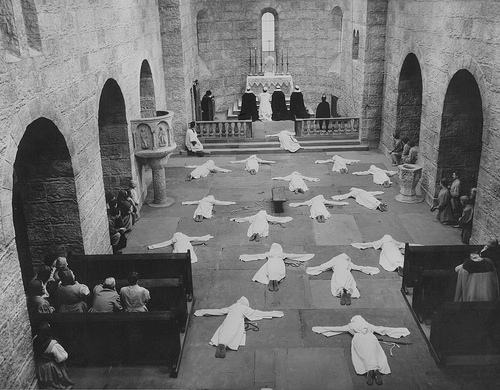
A polish production that is loosely based upon the events that took take in Loudon, France that The Devils film is also sourced from. In this version, a Catholic priest goes to a convent in order to investigate reports of a possible demonic possession by the nuns and most notably their Mother Superior.
Prior to his visit, a local priest was burnt at the stake for sexually tempting the nuns. The priest feels that the only way to heel the Mother Superior is to take on the demon himself and he ends up going mad and killing several local townspeople. He then instructs a girl to go to the convent to tell them of the sacrifice that he has made for them.
The great thing about this film is that it doesn’t force the visuals of a monster onto the audience; it “works precisely because it forces nothing onto its audience. One can approach the austere, at times aesthetic, narrative as a story of the satanic, of actual demon possession; or, conversely, it can be read as a study in repression, sexuality and the pervasive nature of subjective evil” [3].
There are some stunning visuals in this that make it more powerful because it is in black and white; mostly involving the nuns all in white when they go through bouts of hysteria, and when they all lie face down with their arms spread wide out in prayer.
This is one of the movies that set into motion the whole nunsploitation subgenre. It is a cult picture because it is one that is often forgotten and should be viewed as a companion piece to the highly controversial The Devils in order to see the differences in style and storytelling. Director Martin Scorsese has included this one in his Masterpieces of Polish Cinema series [4].
2. The Devils (1971)
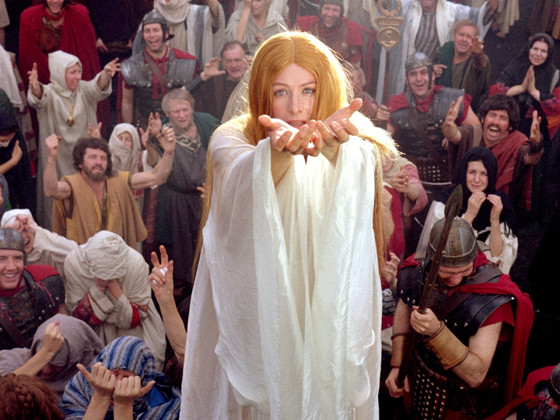
“Hell holds no surprises for them” [5]. By far the most controversial film on this list, it is a historical drama based upon actual events that took place in 17th century Loudun, France. The movie is based partly on two accounts of these events, a 1952 book The Devils of Loudun by Aldous Huxley and a 1960 play The Devils by John Whiting.
Political and religious struggles are taking place as Catholic Cardinal Richelieu wants to demolish the walls of all of the self governing fortified towns, in a further play to rid the country of Protestant religious uprisings.
Most specifically he wants Loudun’s walls brought down, which is now being controlled by the priest Urbain Grandier (Oliver Reed) after the recent governor’s death. Grandier is a proud and strong priest who refuses to let the walls get torn down, but he has his own issues of previous sexual vices and a secret marriage.
The Cardinal wants to get rid of the priest and an opportunity presents it to them when the lustful and jealous hunchback nun Jeanne (Vanessa Redgrave) accuses Grandier of witchcraft and possession. A crazed witch-hunter is brought in and madness and hysteria run through the convent as all of the sexually repressed nuns go out of control. Grandier is sentenced for witchcraft, tortured, and burned alive at the stake as Loudun’s walls are destroyed.
This was and still is a highly controversial motion picture for its political, sexual, and religious content. There are multiple scenes that are highly controversial including one in which Grandier is Christ and Jeanne licks his wounds and they kiss, one where Jeanne is naked and masturbating, and a large scene with all of the nuns naked involved in what appears to be an orgy.
The debate has always been whether the scenes where excessive versus whether they where necessary for the story. The director would argue that all of it was necessary and that they were trying to be as realistic as possible to the actual events that took place. While that may be true, director Ken Russell does have a reputation for having shocking elements and a large amount of nudity in his productions.
The two main actors Reed and Redgrave are excellent in their respective roles. Reed was a British actor, best known for his macho looks, mustache, distinctive scar on his chin, and hellraiser lifestyle. He appeared in several other Ken Russell pictures including Tommy, and Lisztomania.
He received the scar after a bar fight in 1963 and “died of a heart attack in a bar after downing three bottles of Captain Morgan’s Jamaica rum, eight bottles of German beer, numerous doubles of Famous Grouse whiskey and Hennessy cognac, and beating five much younger Royal Navy sailors at arm-wrestling. His bar bill for that final lunch time totaled 270 Maltese liras, almost £450” [6].
Redgrave was a well known actress that has been nominated six times for an Academy Award, winning Best Actress in 1978 for Julia. The overall acting in this may come off as being absurd at times, especially the witch hunter. But that is most likely on purpose, in order to show exactly how absurd and hysterical people became during times when there was the scare of witchcraft.
It received an X rating and was heavily cut by its studio before the release and had other various cuts in Britain and the United States. The DVD releases that exist all vary on the running time and overall picture quality. There is still yet to be a fully restored uncut version or Blu-Ray version of this released.
This has a cult following because of the controversial nature of it and the difficulty in finding a decent quality version. If you like controversial pictures, witchcraft, or are fans of the cast then you should watch this at least once. Just be warned ahead of time that it is pretty graphic.
3. The Nun and the Devil AKA Le monache di Sant’Arcangelo (1973)
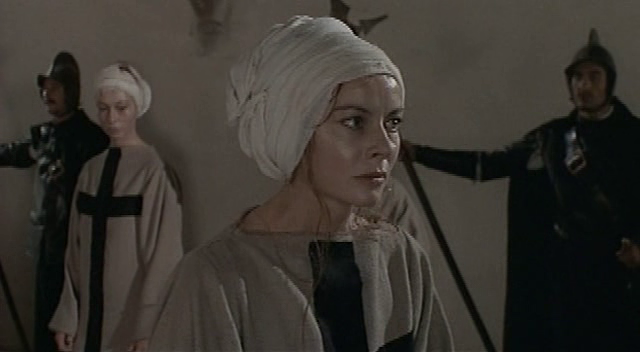
“In the convent of St. Archangel, there is a struggle for lust & love” [7]. This falls somewhere in between the psychological drama and brilliance of Mother Joan of the Angels and the shockingly controversial The Devils.
The Italian and French co-production was clearly made as an attempt to bank off of the notoriety of The Devils, without it pushing the boundaries of possible bans and the dreaded X-rating. The result is more of an erotic thriller that deals with a power struggle between three nuns in the 16th century at a convent in Sant Arcangelo, near Naples and then under Spanish rule.
The opening credits claim that the accounts are based off of authentic records and a story written by the 19th century French writer Marie-Henri Beyle, who went by the pen name of Stendhal.
The Mother Superior of the convent is dying and there is a struggle for who will take her place; this includes a nun that is willing to poison her for control, one that is a lesbian, and one that is having an affair with a man. All three have some type of immoral behavior that ends up being condemned when the Spanish decide to launch an inquisition into their actions, resorting to various means of torture.
The exploitation factor is minimal compared to its predecessor The Devils. There are sexual encounters between both men and women, nudity, and torture scenes but they don’t come anywhere near the level of being shocking or disturbing. This is a Disney movie compared to The Devils, especially when the prior one is in the uncut unbanned version. The torture scenes are well done and feature a nun being tied and hung in some type of contraption, a water torture device, and a vice used to crush their hands.
There are several grand large scale scenes that are excellent and probably rank as the most memorable ones next to the torture scenes. Both scenes take place in very large ceremonial room, the first involves the Cardinal ceremonially ordaining the new nuns and then the final scene is done to kind of call back to this previous one.
The cinematography is superb, but it may be hard to tell depending on the quality of the print that you see of this one. Giuseppe Ruzzolini was the cinematographer for this and also worked on Sergio Leone’s Duck, You Sucker and My Name is Nobody, Stephen King’s Firestarter, and Oedipus Rex. This was popular enough that director Domenico Paolella made another nunsploitation motion picture in the same year titled Story of a Cloistered Nun.
Bottom line, if you’re looking for a shocking exploitation movie with very graphic depictions of sex then this is not what you are looking for. Seek out something else.
4. Flavia the Heretic (1974)
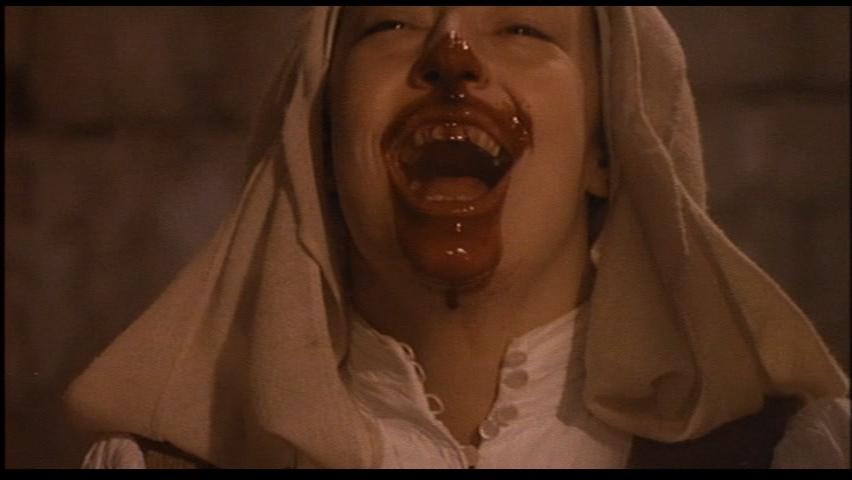
“She Launched a River of BLOOD” [8]. This Italian production tells the story of Flavia during the middle ages, a nun who decides to join the Muslims and revolt against the man driven society. All of her life she has seen nothing but the evil that men do and the subjugation that they maintain over women. It is through all of her bad relationships with men that she decides to turn against everything in order to avenge the tyrannical reign of men.
Despite some graphic imagery, this is less of an exploitation film and more of a story about an early version of feminism. Many of the graphic scenes are used to further propel Flavia and her dislike for men and their power over women. There are graphic scenes of nudity, rape, animal castration, violence and torture but they are used more for the story than to attract a specific audience.
It features a great score from Nicola Piovani, stunning visuals, beautiful location shots, and a very good performance from lead actress Florinda Bolkan. Piovani has 175 credits as a composer and won an Academy Award for Best Dramatic Score in 1998 for Life is Beautiful.
One thing that really stands out is the stunning visuals and location shots around the watery locale of Apulia, Italy. Most of the convent and surrounding areas where also shot in this location, with most of the nunnery being shot in an actual monastery. The cinematography is excellent and makes use of a distinctive pale and washed out brown color palette.
Alfio Contini was the cinematographer on this picture and is noted for also working on Zabriskie Point, the Night Porter, God Forgives…I Don’t, and Il Sorpasso. You can tell that the composer and cinematographer had worked on spaghetti westerns before because this looks and feels like one.
Bottom line, this is definitely a must see for the nunsploitation subgenre.
5. School of the Holy Beast (1974)
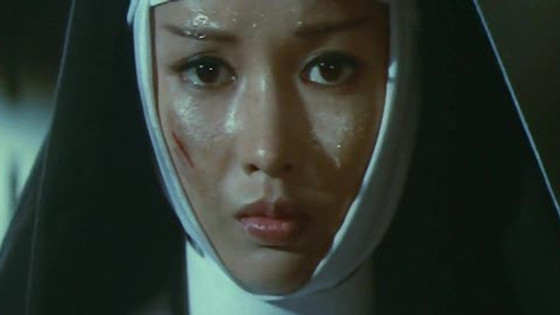
This Japanese production tells the modern story of a young woman who becomes a nun in order to investigate the death of her mother, who was a nun at the convent. What she discovers is a perverse and disturbing group of nuns and a horrifying secret regarding her mother and her birth.
Somehow nobody does it better than the Japanese in creating both the most stylish nunsploitation film and also the most offensive out of them all.
It also has to be considered the best one as well. It has everything you can list that would possibly piss off someone from the Catholic religion; nudity, sexual situations, being nude during a religious ceremony, a creepy cat, nude self-torture scenes, lesbianism, simulation of cunnilingus by showing the licking between two fingers, masturbation, multiple rape scenes, multiple torture sequences, and the urination on the image of Christ.
This can be considered various subgenres of motion pictures. It could be sexploitation or nunsploitation, but it is also commonly linked to the pinky violence subgenre. This was a series of Japanese movies roughly from 1970 through 1974 that had a combination of “action, sex, violence and crime, and was dominated by ruthless and deadly delinquent females” [9].
This new subgenre had mostly been dominated by Toei studios, which by the mid-1960’s had begun to see an increase in the level of sleaze, “nudity, softcore sex and violent bloodshed” it was displaying in them as a way to please an audience that was turning more to television [10].
Despite this being an exploitation flic, it is a beautifully shot with a distinct style and artistry. These were not amateur filmmakers throwing together some crap that has some tits in it; these were very talented artists with years of experience who simply were told they had to make a different type of genre.
Director Norifumi Suzuki is credited with directing 56 films, which include Torakku Yaro and its 7 sequels, Sex and Fury, along with several other films in the Pinky Genre. He also wrote the script for Red Peony Gambler, which also ended up with 7 sequels.
There are many great memorable scenes in this; this includes one where the doors open and the nuns are lined up on each side of the room, the juxtaposition of a self-torture with the imagery of the nuns shadow and the shadow of a cross on the wall, unusual angular shots, and a torture scene with rose petals flying around. It also includes a beautiful score from Masao Yagi, who is credited with composing 81 pictures.
This maybe opinion based, but this is hands down the best of the nunsploitation subgenre. Nobody can match the Japanese ability to blend artistry and offensive imagery together into one beautiful picture.
6. Satanico Pandemonium AKA La Sexorcista (1975)
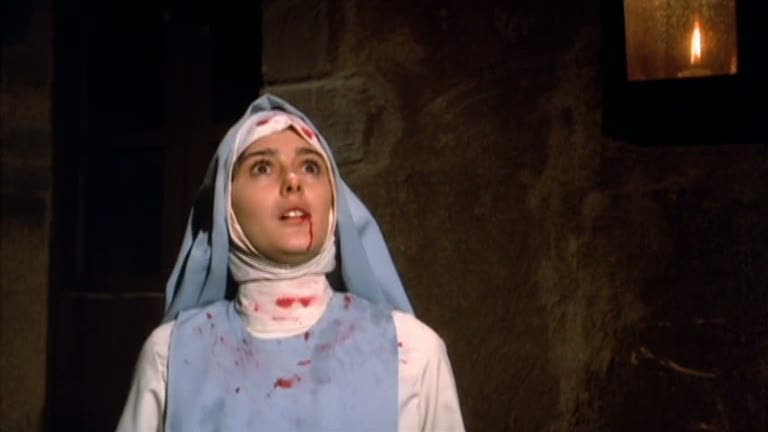
“From Bride of Christ to Slave of Satan” [11]. This was the first of the Mexican nunsploitation films to be released and deals with a nun that is being tempted by Satan and acts out sexual and violent behavior. The ending is left open for interpretation in order to avoid any type of church or government backlash, so it can be interpreted as a either a dream state while she was dying or actual dealings with the devil.
It does contain some strong and graphic material dealing with a sexual and religious nature; including self-torture with thorns and a whip while naked, multiple acts of lesbianism, a rape and murder of a young boy, a mass orgy, and multiple scenes of torturous acts. It was partially inspired by the success of The Devils and also the 1796 book titled the Monk, which was then turned into a 1972 co-production written by Luis Bunuel and starring Franco Nero.
This was written by Adolfo Martinez Solares with the condition being that his father directed the picture. His father was Gilberto Martinez Solares, one of if not the most prolific Mexican and Latin American director ever.
He is credited with directing 162 motion pictures, including a werewolf movie with Lon Chaney Jr., several ones with famed Mexican comedian Tin Tan, and a few featuring Mexican wrestler Santo. Santo was a famous Mexican wrestler. He directed the first movie that featured three popular Mexican wrestling superstars, Santo, Blue Demon, and Mil Mascaras.
This served as an inspiration for Salma Hayek’s character Satanico Pandemonium in the vampire horror picture From Dusk Till Dawn, directed by Mexican Robert Rodriguez.